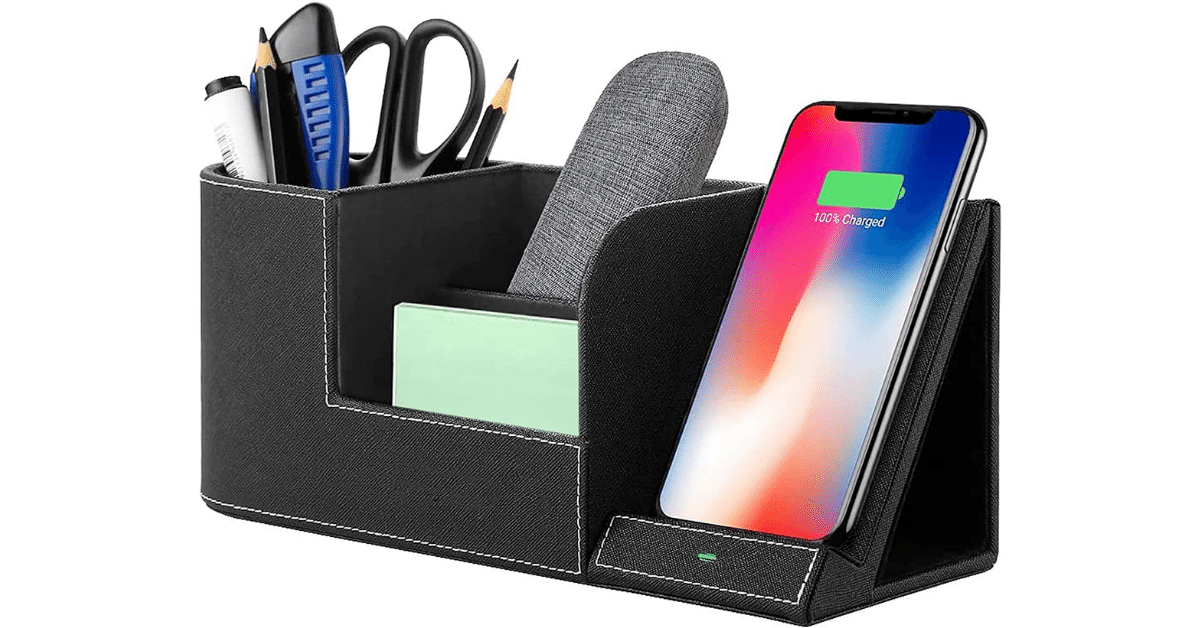Let’s face it: who wouldn’t want to easily charge their device without the hassle of dealing with cords? Fortunately, with the emergence of wireless charging technology, that version of the future is here. In this blog, we’ll cover all you need to know about finding the best wireless charging station for your needs!
Wireless charging offers many advantages over traditional plug-in charging. For example, no longer do you have to plug in multiple devices with multiple cords. With one wireless charger, you can charge two or more devices at the same time. They are also beneficial if you are in an area without access to a wall outlet, such as camping during a power outage.
When purchasing a wireless charger there are several factors to consider. What type of device does it need to charge (iPhone, Android, etc.)? Does the design of the charger fit your lifestyle? How fast does it charge and how much do you need to invest?
We have researched and reviewed the best wireless chargers available on the market and compiled this guide so that you can find one that fits your needs and budget. We will discuss features and specs for each product as well as pros and cons. Finally we provide a buying guide so that you can find the right wireless charging station for your devices.
Benefits of Wireless Charging
Wireless charging offers a convenient and efficient way to keep all of your digital devices powered up and ready for daily use. Compared to a traditional wired charging station, wireless charging stations can provide additional benefits in terms of speed, safety, portability, and versatility.
Speed: Wireless chargers are able to recharge devices faster than their traditional wired counterparts because they don’t require connecting multiple cables to the device. This significantly reduces the amount of time required for your phone or tablet to regain its charge.
Safety: Charging your device with a wireless station is a much safer option than plugging it directly into an outlet due to the fact that most wireless chargers are designed with protective components that keep potential electric and fire hazards at bay.
Portability: With no cords or wires involved, wireless charging stations are extremely easy to transport and store when not in use – you can simply grab yours out of the drawer during travel or carry it around your home without having to worry about accidentally unplugging any cords.
Versatility: Many devices are now equipped with Qi-compatible receivers so that they can take advantage of today’s latest advancements in the digital world. This means you can charge not just your phone but also tablets, smartwatches, headphones – even digital cameras! – by using just one wireless charger platform.
Different Types of Wireless Charging Stations
Wireless charging stations come in a range of types and sizes to best suit different needs and styles. Many stations are built for desktop use, making them suitable for office environments, while others are designed with consumers in mind to be used at home or on the go. Below are some of the most popular types of wireless charging stations.
Top 3 Desktop Wireless Charging Stations in 2024
Desktop Station-Desktop wireless charging stations offer power directly from an AC wall outlet, giving you more versatility in the types of devices they can charge at once. Larger models feature multiple pads and higher power outputs, allowing you to charge up to 4 devices simultaneously. They’re typically made with features like overcharge protection or multiple coils for improved charging accuracy.
Top 3 Portable Wireless Charging Stations in 2024
Portable Station – Portable chargers are great for travel and offer a convenient way to keep your device (s) charged up on the go in any location. These smaller stations can be plugged into any USB port or AC wall outlet and can even be used with solar energy when travelling outdoors.
Top 3 Magnetic Resonance Wireless Charging Stations in 2024
Magnetic Resonance Stations – Magnetic resonance chargers send an electromagnetic field through air which is then picked up by a receiver coil embedded in the device being charged, allowing you to wirelessly charge your device from further away than traditional inductive pads do. This means it’s much easier to quickly charge multiple devices at once without having to perfectly align them on each pad as required by inductive charging technology.
Top 3 Qi Standard Wireless Charging Stations in {wpdts-year]
Qi Standard Stations – As one of the most popular wireless power standards, Qi Standard wireless charging pads use electromagnetic waves emitted from a copper coil inside the charger that transmits energy into a specially designed receiver pad inside your device where it creates electric current which powers up your gadgets. The main advantage that Qi Standard has over its competitors is that it supports “fast charge” which means certain phones like the iPhone XS Max can get their battery levels back up in no time!
How to Choose the Best Wireless Charging Station
When you are looking for the best wireless charging station, there are many factors to consider. With modern technology advancing so rapidly, it is important to find the best choice based on your lifestyle and needs. The following guide provides tips for selecting a wireless phone charger that will meet your needs.
First, consider what type of wireless charging device is compatible with your phone. Many wireless chargers have different compatibility requirements, and it is important to make sure the charger you choose will work with your device. You should also determine if the charger can be used for multiple devices or is limited to a single phone.
Second, check what type of surface area you need for efficient charging range and power output from the charger station. Many models come with an attached plate or stand that holds up a device while it charges while others require direct contact with the base unit itself. Knowing which option best fits your lifestyle can help you choose a product that meets all of your requirements.
Third, compare different aspects such as design, portability, cost effectiveness and convenience when deciding on a charger station. There are many factors to consider including price points, size and wattage outputs in order to determine which model will work best for your needs. Additionally, research any extra features that may come in handy such as multiple output ports or USB fast charge capabilities in order take advantage of current technology advancements.
Finally, compare reviews from other users who have purchased similar chargers before committing to a product in order to make an informed decision about which model works best for you and provide value for money long-term use over time.. This can help provide useful insights into details such as effective charging range or potential malfunctions before purchasing
Features to Look for in a Wireless Charging Station
When choosing a wireless charging station, there are several factors to consider that will help you find the perfect device for your needs.
First and foremost, look for a unit that offers high speed charging. Most Qi-certified devices provide power up to 15 watts; for faster speeds, you may need to choose a model with Adaptive Fast Charging (AFC) technology. This can shorten the time it takes to charge your device.
Additionally, consider the size and shape of your device. Many wireless charging stations can accommodate multiple devices at once, making it easier to simultaneously charge different mobile devices at one time. Many units also come with adjustable cradle positions to hold smartphones of all shapes and sizes securely while they charge.
In addition to the features mentioned above, look for convenience features like LED indicators or compatibility with specific brands or models of phone or other mobile devices you have. LED indicators show how much power is available when you plug in so that you know when your wireless charger is ready to go; compatibility ensures that every device will play nice with the station so there’s no confusion in selecting which one it is compatible with. Most importantly, pick up a wireless charging station from a trusted manufacturer who provides reliable customer support and warranty protection if something goes wrong down the road.
Advantages of Wireless Charging Stations
Wireless charging stations offer many advantages over traditional wired chargers. By eliminating the need to plug in cords and cables, they free up desk space and simplify device management. Additionally, wireless charging stations make it easy to share phone power between different devices, as most charging mats can support multiple phones from a single power source. This is especially useful for families or groups of friends who want to charge multiple phones at once.
In addition, wireless charging stations are stylish and can be customized to match any décor. It’s easier than ever to find the perfect charger for your lifestyle – no more compromising on form factor or color! Finally, many newer models come with highly advanced safety features such as built-in protection against overheating and overcharging, ensuring that your device is always safe from harm while being charged.
Common Issues with Wireless Charging Stations
When using wireless charging stations, there are some common issues that may arise. These problems can range from compatibility issues with the device being charged to inefficient or incorrect power levels being supplied to the device. Below are some of the most common types of problems experienced with wireless charging stations:
• Compatibility Issues – Depending on what type of device is being charged, compatibility can be an issue. Many devices require specific wireless technologies or standards which must be met in order for a successful charge to occur. Check your device specifications before purchasing any wireless charger or station.
• Incorrect Voltage/Current Levels – Devices require different amounts of voltage and current in order to charge properly. If too much voltage/current is provided, then it can potentially damage your device and shorten it’s life-span. Always check that the station provides the correct levels and matches your specific device requirements before use.
• Poor Contact Points – The main point at which all power and data is transferred is called a contact point; these are located on the front face of Qi standard compatible phones, tablets and other compatible devices. Ensuring these contact points are in solid working order should be checked first for optimal performance; if not then this could result in a slower charging process or even failure altogether.
Also check that the ground holding points on either side of the station aren’t worn away or loose – this could also mean poor performance when charging wirelessly due to connection instability between all parts involved.
• Heat Build-up – Many chargers/stations will become excessively hot if used for long periods of time due to build-up of energy; this heat can negatively affect both electrical components within, as well as any devices connected – reducing lifespan considerably if not maintained accordingly by switching off every few hours for adequate cooling down time and avoiding continuous heavy usage overnight/for extended periods without breaks. Ensure ample ventilation when using such equipment whenever required.
Conclusion
After careful evaluation, the best wireless charging station for most users is the Anker PowerWave Pad. This device offers up to 7.5-watts of power and is compatible with most modern devices, including those with a non-native Qi connection. It also offers a sleek design that ensures you don’t have to sacrifice style for convenience.
Furthermore, its included Quick Charge adapter ensures optimized performance and fast charge times, while its built-in temperature control chip helps protect your device from overheating. Finally, its foldable kickstand prop allows you to find just the right angle while charging. With all this plus a guaranteed wireless connection, the Anker PowerWave Pad is worth considering if you’re looking for an effective way to charge your device wirelessly .















